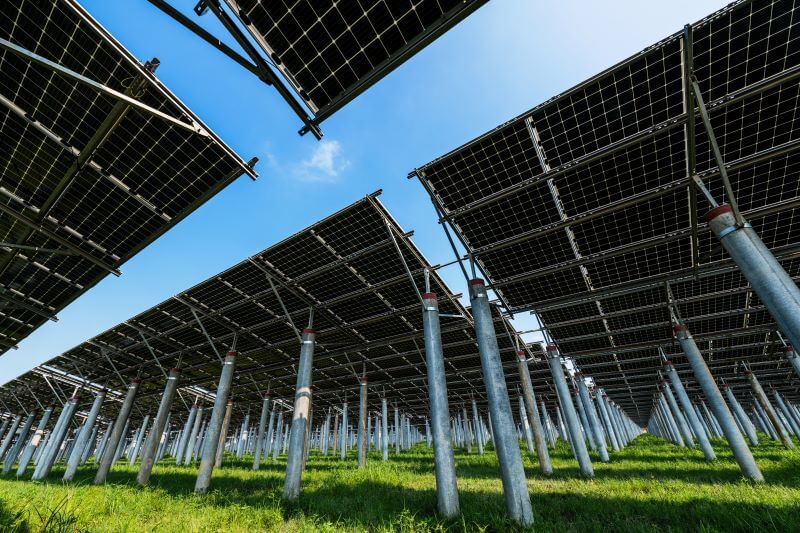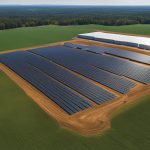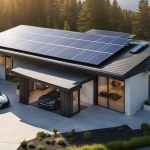Table of contents
Introduction of Solar Panel Mounting Ideas
The advent of solar energy has heralded a new era in renewable energy, with mounting brackets playing a pivotal role in maximizing efficiency and functionality. Solar panel mounting structure is not just about securing panels; it’s a thoughtful integration of technology into various settings, be it residential, commercial, industrial, or utility-scale. The choice of mounting significantly impacts the efficiency, durability, and even the aesthetics of solar installations.
In this comprehensive overview, we’ll explore the spectrum of solar panel mounting ideas, highlighting their unique characteristics and applications. From the traditional roof solar and ground mounts to more creative solutions like solar carports and pergolas, each option offers distinct advantages and considerations. Our journey through these mounting options not only aims to inform but also to inspire, showcasing how solar energy can be seamlessly integrated into our daily lives, contributing to a greener, more sustainable future.
Roof Solar Panel Mounts
The landscape of solar power is diverse, and roof mounts exemplify this variety. They are the quintessential choice for many, offering a blend of convenience, efficiency, and aesthetics. Roof mounts adapt to the unique contours and characteristics of different buildings, making them a go-to option for mounting solar panels.
Residential Roof Mounting Systems: Adapting to Home Architecture
In the residential sector, roof solar mounting systems are particularly popular due to their space-saving nature and minimal visual impact. They seamlessly integrate with the existing architecture, preserving the aesthetic appeal of homes while harnessing green energy through solar energy systems. Residential roofs come in various shapes and sizes, from steep pitches to modern flat designs, each requiring a specialized approach.
Many houses have pitched roofs and need special mounts to attach solar panels safely without damaging the roof. It’s important to make as few changes as possible to the roof to stop leaks. The solar panel roof fixings used should be strong but not too heavy. The commonly seen solar roof mounting hardware includes aluminum rails, panel clamps, and roof hooks. The system is usually easy to install, making DIY solar optional.
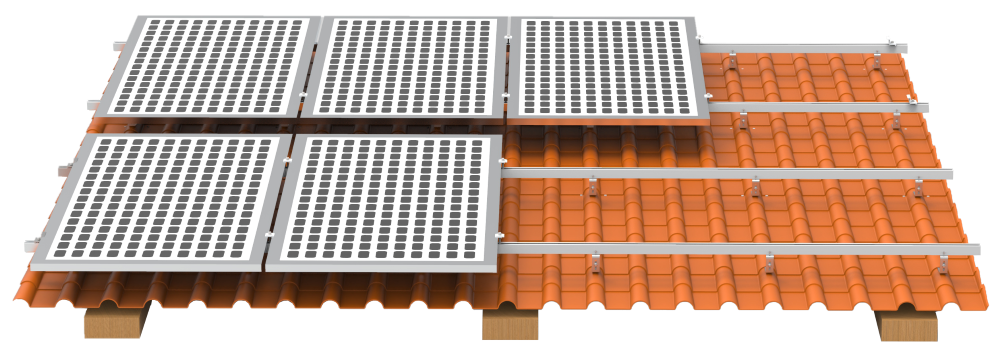
Flat Commercial Roof Mounting Systems: Maximizing Space and Efficiency
Commercial buildings frequently feature expansive flat roofs, ideal for large-scale solar installations. These setups can support substantial solar arrays, contributing significantly to a building’s energy needs. Commercial roof mounts are engineered to occupy maximum space without impeding roof access for maintenance.
To maximize space usage in these environments, a low-profile ballasted east-west orientation system can be deployed. This orientation allows for more panels to be installed, as they can be placed closer together without casting shadows on each other. It’s a smart choice for businesses looking to reduce their carbon footprint and energy costs.
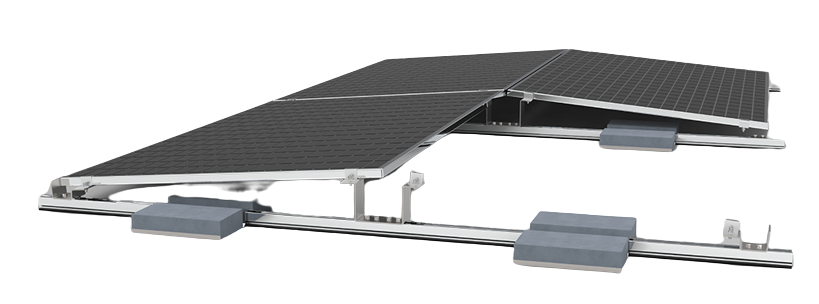
Industrial Metal Roofs: Durable and Robust Mounting Systems
Industrial environments require strong and long-lasting mountings. These systems are flexible and can be adjusted to fit different types of industrial roofs, such as corrugated and standing seam metal roofs. They are installed in a way that takes care of the roof’s features, making sure they last long and are reliable in tough conditions. In places with strong winds, it’s best if the weight of the panels is supported by the rafters below. However, this involves making holes in the roof sheets, so it’s crucial to think about waterproofing when selecting and setting up the solar system.
Ground Solar Panel Mounts
Double Column Ground Mounting Brackets: Sturdy and Scalable
Double-column aluminum or steel ground mounted solar panel stands are notable for their strength and scalability. These systems are ideal for large-scale installations, such as solar farms or commercial projects, where vast arrays of panels need robust support. The dual-column design provides a stable base capable of withstanding severe wind and snow loads.
These ground-mounted systems are highly customizable, accommodating various terrains and soil types. The use of aluminum and steel ensures long-term durability and resistance to corrosion, crucial for maintaining structural integrity over the lifespan of the solar deployment. Additionally, their modular nature allows for scalability, enabling the system to expand as energy needs grow.
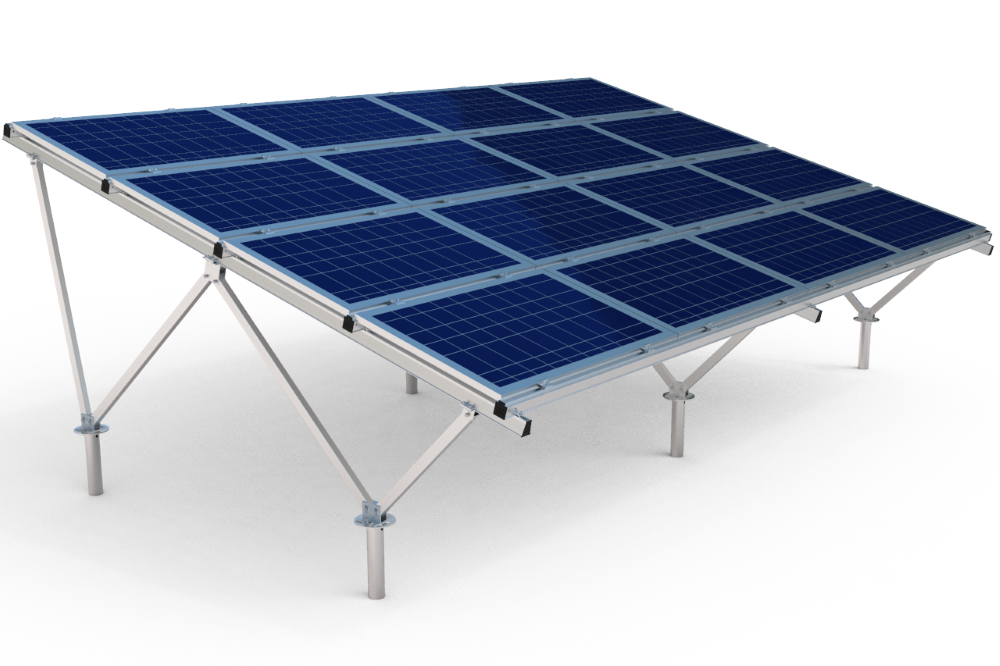
Single Column Pile-Driven: Simplified and Effective
The Single Column Pile-Driven mounting system represents a significant advancement in solar panel installation, particularly beneficial for uneven and challenging terrains. This innovative method utilizes specialized machinery that drives support piles directly into the ground. This approach significantly reduces the need for extensive soil preparation, a common challenge in traditional installation methods. The simplicity and speed of the pile-driven process not only save time but also reduce labor costs, making it an ideal solution for quick and efficient installations.
Moreover, the design of the Single Column Pile-Driven mounting system is specifically tailored to adapt to various topographical challenges. It provides a robust and stable foundation for solar panels, even in areas where conventional mounting systems would struggle. This system minimizes the need for extensive groundwork, which is a crucial advantage when dealing with sloped, or irregularly shaped landscapes. Its versatility and adaptability make it a preferred choice for projects that require a swift and reliable mounting solution, ensuring that solar panels are securely and optimally positioned, regardless of the underlying terrain.

Integrating Solar into Everyday Structures
As solar technology becomes more integrated into our daily lives, innovative applications like solar carports, solar canopies, and pergolas are emerging. These structures blend functionality and aesthetics, transforming everyday spaces into sources of clean energy.
Solar Carports: Dual-Purpose Energy and Vehicle Protection
Solar carports are a unique blend of practicality and sustainability. They serve the dual purpose of providing shelter for vehicles while harnessing solar energy. These carports are designed with panels mounted on the roof, turning an otherwise idle space into a productive energy-generating area. They are ideal for both residential and commercial settings, including homes, office buildings, and public spaces like parks and schools.
Furthermore, solar carports can be equipped with electric vehicle (EV) charging stations, making them a forward-thinking solution in the transition to electric transportation. They not only provide the necessary infrastructure for EVs but also ensure that the energy used for charging is sustainably sourced.
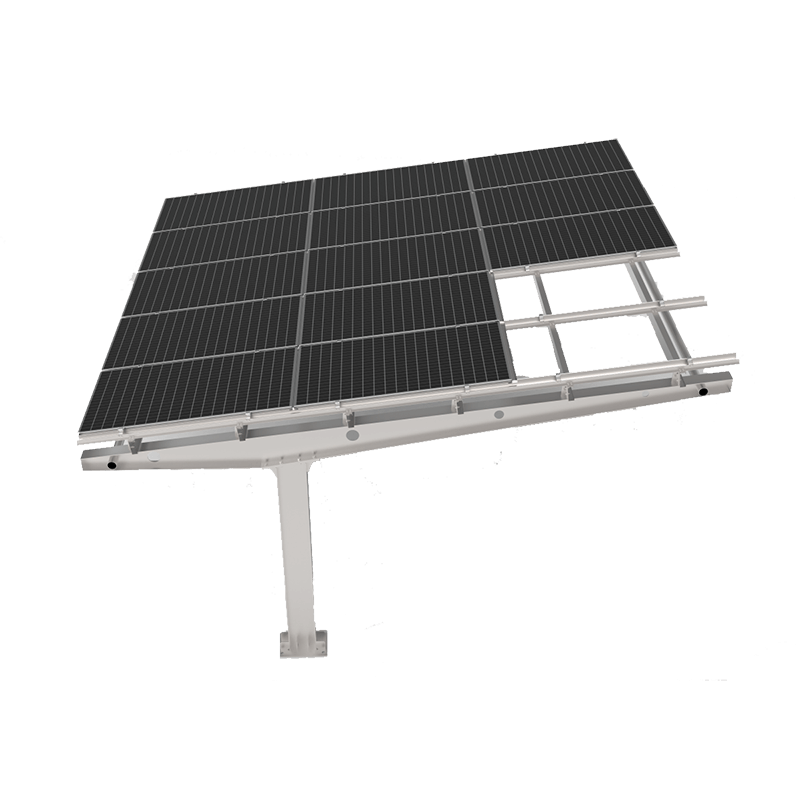
Pergolas, canopies: Aesthetic and Functional Solar Integration
Pergolas with integrated solar is another innovative way to incorporate solar energy into everyday structures. These structures are especially appealing in residential gardens or as part of commercial landscaping, where they serve as a focal point while producing renewable energy. Solar pergolas can provide shade and comfort in outdoor living spaces while reducing reliance on traditional energy sources.
The integration of solar technology into structures like carports and pergolas represents a significant step forward in making renewable energy a part of everyday life. These applications demonstrate the versatility and adaptability of solar technology, offering practical, aesthetic, and environmentally friendly solutions for energy generation.
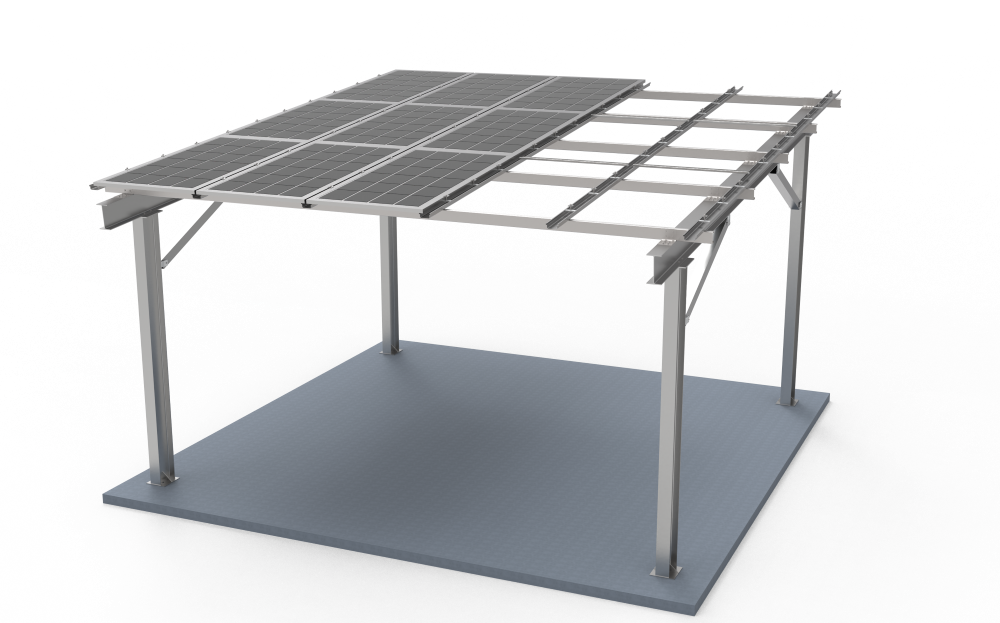
Innovative Solar Mount Approaches
The solar industry constantly evolves, bringing forth innovative mounting solutions that cater to unique installation challenges and maximize solar efficiency. Among these are the ballasted east-west orientation mounts and balcony solar panel supports, each addressing specific spatial and structural requirements.
Ballasted East-West Orientation Mounts: Maximizing Space Utilization
Unlike traditional south-facing roof-mounted solar panels, ballasted east-west orientation systems position panels facing both east and west. The design of these mounts eliminates the need for roof penetrations, securing the panels with the weights of the system itself and the ballast blocks. This is particularly advantageous for buildings where roof integrity is a concern. This approach also allows for higher density in panel placement, as the shadowing between rows of solar modules is significantly reduced. As a result, it is possible to install more panels within the same roof area, enhancing the overall energy yield.
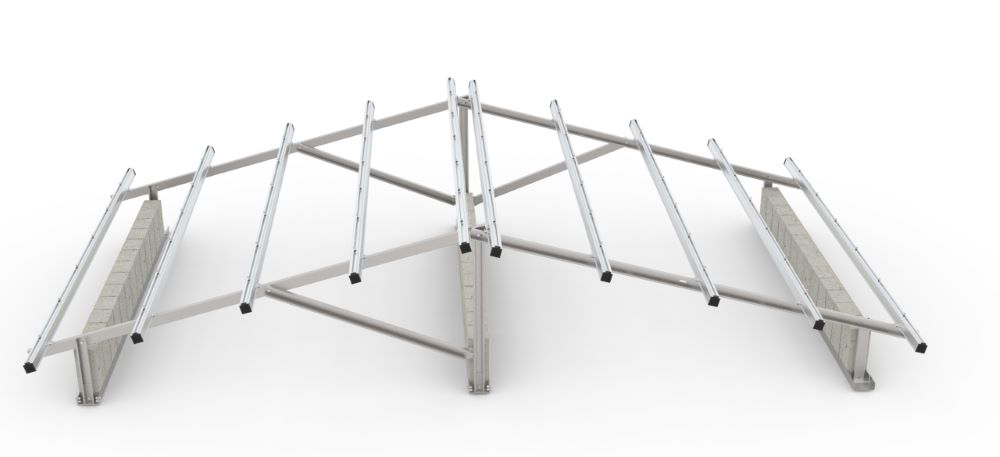
Balcony DIY Solar Mounting System: Harnessing Solar Energy in Compact Spaces
Balcony solar is a testament to the adaptability of solar technology in urban environments. They offer a solution for apartment dwellers or those with limited roof space, allowing solar panels to be mounted on balconies or railings. This approach not only utilizes previously untapped spaces for energy production but also encourages solar adoption in urban settings where traditional panels on your roof might not be feasible.
Innovative mounting approaches like ballasted east-west and balcony solar mounts demonstrate the solar industry’s ingenuity. By developing solutions tailored to specific challenges and settings, these mounts expand the possibilities of solar energy, making it more versatile and adaptable to varying needs and environments.
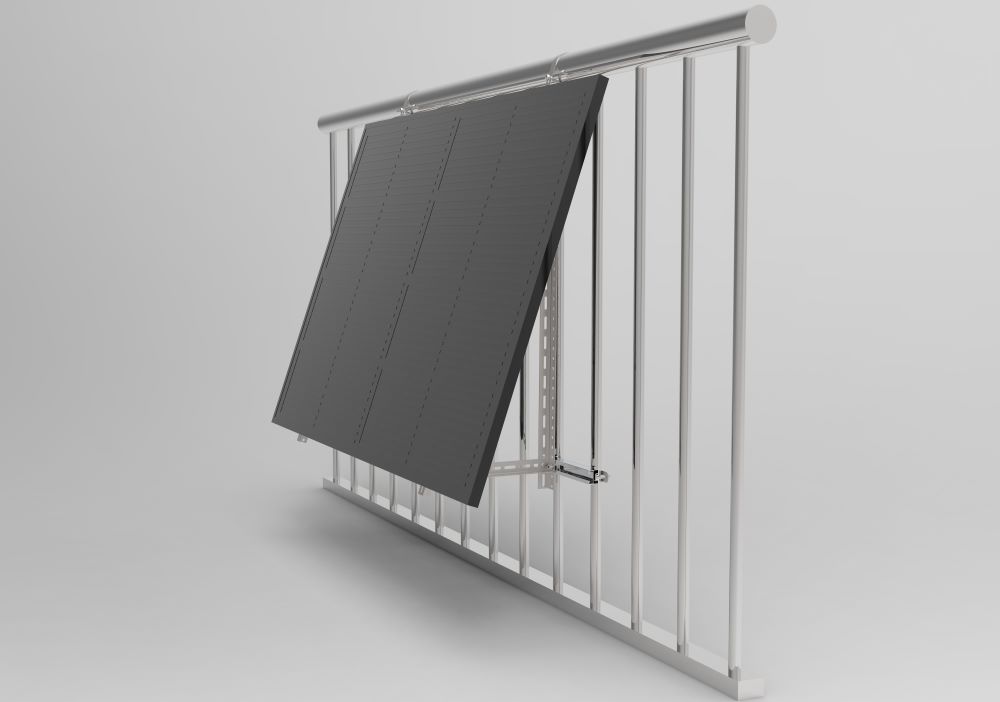
Considerations for Selecting the Right Mounting Hardware
Choosing the right solar panel mounting system is crucial for maximizing the efficiency and longevity of a solar asset. Several key factors influence this decision, each playing a vital role in determining the most suitable mount for a given scenario. Whether it’s for a residential, commercial, or industrial application, understanding these considerations ensures a well-informed choice.
Environmental Factors: Weather and Location
The environmental conditions of the site significantly impact the choice of mounting system. Factors such as wind speed, snow load, and seismic activity dictate the structural requirements. For instance, areas with high wind speeds necessitate robust mounting systems that can withstand such forces, while regions with heavy snowfall require mounts capable of supporting additional weight.
The geographical location also influences the optimal orientation and angle of the solar panels. In the Northern Hemisphere, south-facing installations typically yield the best results, but this can vary based on specific site conditions and latitude.
Space Availability and Constraints
The availability of space is a critical factor. Panels on the rooftop are ideal for limited space, as they utilize existing structures. However, ground-mounted solar is preferable in scenarios where ample open land is available, as they allow for larger, more scalable setups.
In urban settings, space constraints often lead to creative solutions like balcony mountings or solar pergolas, which blend functionality with limited spatial availability. The key is to maximize solar energy production within the given space.
Budgetary Considerations
The budget plays a significant role in racking selection. While some options may offer higher efficiency, they might also come with a higher price tag. It’s essential to balance the initial investment cost with the long-term benefits and savings.
Quality and Durability
The quality and durability of the mounting system are paramount. High-quality materials like aluminum and stainless steel offer longevity and resistance to corrosion and environmental wear. Investing in a durable system ensures the solar installation remains secure and efficient over its lifetime.
Regulatory and Permitting Requirements
Lastly, regulatory and permitting requirements can influence the choice of mounting system. Local building codes, zoning laws, and aesthetic considerations can all dictate what types of mounts are permissible. It’s crucial to understand these requirements to ensure compliance and avoid potential legal issues.
By carefully considering these factors, one can choose the most appropriate solar panel mounting system for their specific needs. This not only optimizes the performance of the solar installation but also ensures its feasibility and compliance with local regulations.
Conclusion
In navigating the world of solar panel mounting options, we’ve explored a diverse range of solutions, each tailored to meet specific needs and challenges. From the rooftops of residential homes to the sprawling spaces of commercial and industrial facilities, and from innovative carports to aesthetically pleasing pergolas, solar panel mounts have evolved to offer practical and efficient ways to harness solar energy.
The journey through various mounting options underscores the importance of customization in solar installations. Whether it’s adapting to the unique architecture of a building, considering environmental factors, or aligning with budgetary constraints, the right solar panel mount can significantly enhance the efficiency and viability of a solar power system and maximize sun exposure.
This exploration also highlights the ingenuity within the solar industry, showcasing how technological advancements have led to innovative and adaptable solutions. The integration of solar panels into everyday structures like carports and pergolas exemplifies this creativity, merging functionality with design and bringing solar energy closer to daily life.
As we look towards a future where renewable energy becomes increasingly crucial, the significance of selecting the right solar panel mounting system cannot be overstated. It’s not just about installing solar panels; it’s about integrating them into our lives in a way that is both practical and sustainable.
